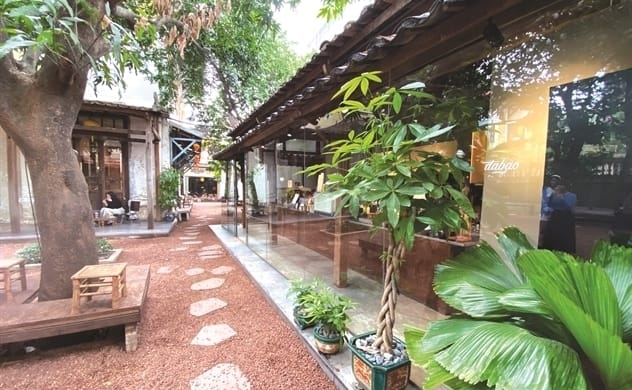
Photo: Quy Hoa
Tu Phu Coffee, which was properly invested and had a beautiful site, closed in July. Ho Chi Minh City’s youth are already familiar with big-invested coffee shops. Mellower Coffee, Café Saigon La Poste, Saigon Casa, and Tu Phu are not the first to fail.
Two styles in one battlefield
Since “zero dong franchising” Milano, Napoli arrived in 2012, Ho Chi Minh City’s coffee chain development has followed two paths. The first trend is enormous premises, gorgeous location, air conditioning open 24/24 with representatives like Starbucks, Highlands Coffee, Phuc Long… and the popular trend (investment in premises is considerably lower) with representatives like Milano, Napoli, Guta.
In particular, the group that invests in the “beautiful” is separated into two distinct parts, namely the group of businesses like Tu Phu, Saigon Casa… with substantial investment expenses on the premises (over VND1 billion), Average price of the drink is VND 50,000 or more. The second group, with a lower investment in the premises (average VND 1 billion) but nonetheless lovely sites, with a price of VND 30,000 or more for drinks.
In the past decade, Starbucks represented the attractive and wealthy. Highlands Coffee is still the most popular chain in the gorgeous mid-range category, which includes domestic and overseas brands including The Coffee House, Passio Coffee, and Highlands Coffee.
Social media also noticed the attractive foursome. From January 1 to June 14, YouNet Media captured approximately 700,000 online talks of 10 Vietnamese coffee chain brands, all of which are in the beautiful category. Highlands Coffee leads with almost 272,000 talks, followed by The Coffee House (120,046) and Phuc Long (120,017).
Highlands Coffee lost VND 19 billion in 2022, according to VnExpress, and its revenue decreased to 1,700 billion dong. Starbucks has not reported revenue. When a top sales and profit brand like Highlands is struggling, it’s impossible to expect other chains to do better.
The exquisite coffee chain is affected by two variables. According to FnB Director Mr. Do Duy Thanh, premises cost 20–25% of beverage chain sales. Changes in customer behavior are the second. According to PwC’s “Consumer habits in Vietnam 2023” research, 62% of consumers will cut non-essential spending, and 54% will cut luxury expenditure. These two variables have had a big impact on firms who have invested extensively in premises, especially chains because the profit margin in this industry is only 7-10%.
Meanwhile, less spoken about but representative in the popular segment, with the identifying traits of modest premises, no air conditioning, good coffee quality, and in the popular price range, is doing well thanks to better cost optimization. Depending on the location, coffee shops in this group cost VND 120–180 million to invest.
Milano typically has more than 1,800 franchised stores countrywide. The Milano coffee chain’s creator, Mr. Le Minh Cuong, indicated that the company chooses a franchise partner based on the premises’ investment cost and purchasing power. Milano coffee costs 25,000 VND for every cup since space costs are only VND4,000 per cup. “Coffee is a daily drink, so besides quality, we believe it should be at a price that is suitable for the vast majority of people,” said Mr. Cuong.
Guta, listed in the Top 5 coffee brands with the most branches, entered the new market after 7 years and with less financial potential than prior enterprises, yet it has 120 franchised locations (primarily in HCMC). The firm continues to seek expansion prospects. “The selling price has a great influence on the chain’s scalability,” according to Guta creator Nguyen Minh The. Mr. The have tried common and high-end coffee business concepts to discover the optimal development form.
 |
| There is a change in the investment of coffee chains in the region. Photo: Quy Hoa |
Leverage technology and new cash flow
Most coffee chains have two goals: one is to join a larger business’s ecosystem (like Phuc Long or PhinDeli). bought by IN Dining); second is franchising (Highlands Coffee, Guta, Milano, Napoli…).
This flow is being stopped by severe economic conditions and is expected to return to the former rule. However, coffee chains are investing differently in the region. The Jakarta Post reports that financial inflows into coffee companies using technology to manage are warming up Indonesia’s internet winter. Flash Coffee (Singapore) recently raised 50 million USD in a series B investment deal. Indonesia has 92 profitable outlets for the brand.
Kopi Kenangan, the country’s largest coffee chain (850 locations in 32 cities), reported earlier that it had secured $109 million in a series B investment from multiple investors.
Even while investors demand an increase in chain numbers, experts informed the Jakarta Post that coffee chains using this technology are profitable. Technology coffee chains overcome the profit dilemma by offering lower pricing and fewer employees.
Kopi Kenangan, which has eight outlets in Malaysia, is scheduled to reach 100 points by 2024. Markets These brands seek a huge population, high per capita coffee consumption, and rising average income.
Most Vietnamese coffee chain representatives are ready for this trend while addressing technology. Guta’s Mr. The said the company spends extensively in technology for management and operation for three reasons. First, technology streamlines operating operations, saving more operating staff. Second, clients use cash, e-wallets, FoodApp, and other payment methods, so only technology can limit cash payments and precisely track daily cash flow.
Finally, manage client data synchronously on the Guta App to simply analyze data, be proactive in care programs, and attract new consumers through appointment scheduling. Pickup time, cashback, monthly coffee package incentives… These programs are totally automated by technology. “Guta is franchising, but management technology is our top concern on behalf of the investor and operating the entire system,” stated Mr. The.
Milano’s representative views franchise partners as the Company’s primary customers. Thus, early investments were made in ordering, revenue management, and internal information-sharing technologies. These partners are especially interested in product variety to respond to new customer trends. Milano built a roasting plant to meet this need. “We’re upgrading our technology to serve customers and will announce it soon,” said Mr. Cuong.
When Vietnam achieves the population size and coffee consumption criteria, it is possible to predict the next technological chains that will land in Vietnam. At that moment, Vietnam’s coffee chain investment capital flow will be harmed and the incoming coffee chain’s competition will not be enough.





